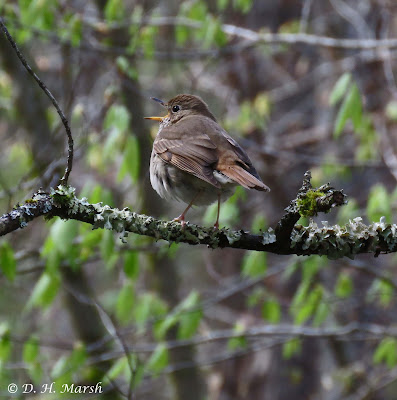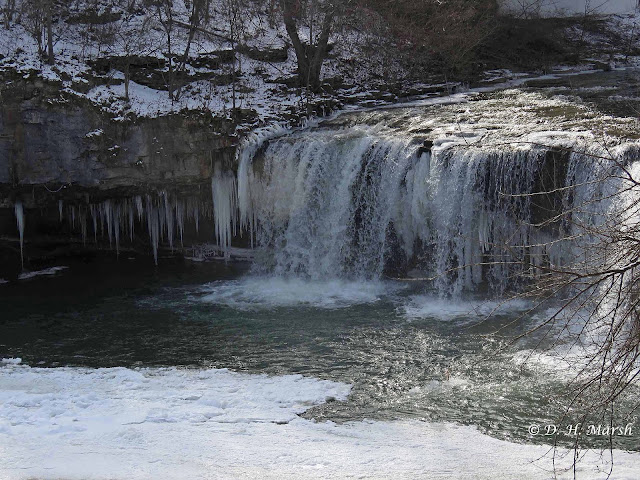Our recent forays began in 2013 when we signed up for a field trip to the highlands that was part of the New River Nature and Birding Festival. Led by ace Ohio naturalist Jim McCormac, the trip featured the Cranberry Glades Botanical Area, a refuge for plants and animals which are usually associated with areas far to the north. The high altitude, long ago glaciation, underlying geology and relative isolation have allowed formation of sphagnum bogs, red spruce and hemlock forests, and a lush understory of ferns and wildflowers. That trip opened up a whole new area of exploration for us and we have returned many times since then.
Our most recent trip was just last week. A major feature on the way to the highlands is the New River Gorge, formed by one of the oldest rivers on the continent:
Flanked by steep sandstone cliffs and verdant hillsides, the river is quite popular with whitewater rafters.
As we drove higher we began to see some trees and shrubs that were quite different from what we typically see in Ohio. Here is the dramatic bloom of a Fraser magnolia:
Another tree that we noticed as we drove along in the highlands was Bartram's Serviceberry, which is easily distinguished from the serviceberry which is common here in Ohio (Amelanchier arborea) by the coppery early spring foliage:
Here is a closer look at the leaves and flowers:
I also noticed a flowering shrub that I couldn't immediately identify:
A closer look revealed it to be red elderberry, a cousin of the white-flowering elderberry that is common in wetter areas here in Ohio.
Once we got to the highlands we started with a walk around the boardwalk that traverses the Cranberry Glades, near the Cranberry Mountain Nature Center in Pocahontas County. The weather was cool and misty, giving the area an other-worldly atmosphere.
In the foreground is the sphagnum bog where cranberry plants will soon be blooming. The bog also features two carnivorous plants that will bloom later in the summer: sundews and pitcher plants. In the background are spruce trees, found much more commonly far to the north.
Along the boardwalk the marsh blue violet was present in large numbers:
As we reached the end of the boardwalk we noticed this gorgeous painted trillium:
These trilliums are quite rare in Ohio but we saw many of them in West Virginia last week--more than we have ever seen before!
After traversing the boardwalk, we spent a lot of time on the Highlands Scenic Highway (SR 150) through the Monongahela National Forest, and its various side roads and trails. Views were wonderful, even though the day was overcast, and we had a picnic at this lovely spot:
Here are some of the wildflowers that we encountered along the roads and trails:
We heard a lot of warblers singing in the forest, but most were hard to see and impossible to photograph. This hermit thrush, though, was quite cooperative:
Now we are looking forward to another visit to the West Virginia Highlands in early summer, when Canada lilies, rhododendrons, white clintonia, and many other spectacular plants will be in bloom!
Our most recent trip was just last week. A major feature on the way to the highlands is the New River Gorge, formed by one of the oldest rivers on the continent:
Flanked by steep sandstone cliffs and verdant hillsides, the river is quite popular with whitewater rafters.
As we drove higher we began to see some trees and shrubs that were quite different from what we typically see in Ohio. Here is the dramatic bloom of a Fraser magnolia:
Another tree that we noticed as we drove along in the highlands was Bartram's Serviceberry, which is easily distinguished from the serviceberry which is common here in Ohio (Amelanchier arborea) by the coppery early spring foliage:
Here is a closer look at the leaves and flowers:
I also noticed a flowering shrub that I couldn't immediately identify:
A closer look revealed it to be red elderberry, a cousin of the white-flowering elderberry that is common in wetter areas here in Ohio.
Once we got to the highlands we started with a walk around the boardwalk that traverses the Cranberry Glades, near the Cranberry Mountain Nature Center in Pocahontas County. The weather was cool and misty, giving the area an other-worldly atmosphere.
In the foreground is the sphagnum bog where cranberry plants will soon be blooming. The bog also features two carnivorous plants that will bloom later in the summer: sundews and pitcher plants. In the background are spruce trees, found much more commonly far to the north.
Along the boardwalk the marsh blue violet was present in large numbers:
As we reached the end of the boardwalk we noticed this gorgeous painted trillium:
These trilliums are quite rare in Ohio but we saw many of them in West Virginia last week--more than we have ever seen before!
After traversing the boardwalk, we spent a lot of time on the Highlands Scenic Highway (SR 150) through the Monongahela National Forest, and its various side roads and trails. Views were wonderful, even though the day was overcast, and we had a picnic at this lovely spot:
Here are some of the wildflowers that we encountered along the roads and trails:
 |
| Wild geraniums and miterwort were common on the lush hillsides. |
 |
| This is the unusual rose form of Trillium grandiflora, the state wildflower of Ohio. It is pink during its entire blooming period, as opposed to the white form which turns pink after it is pollinated. |
 |
| Canada violets are one of the taller violets, and feature yellow centers and a blush of purple on the back of the petals. |
 |
| Phlox stolonifera, or creeping phlox, added beautiful color to the sides of some of the side roads. |
We heard a lot of warblers singing in the forest, but most were hard to see and impossible to photograph. This hermit thrush, though, was quite cooperative:
 |
| Here it shows its white undertail coverts, presumably to scare away potential predators. |
 |
| The hermit thrush has a beautiful song, but this one was giving a sharp vocalization instead. |
Here is a video:
We figured that we were too early in the season for the flowers of the yellow clintonia or blue-bead lily. We saw large colonies of the plants and we were pleased when we spotted a few that had started to bloom.
On our way back to the New River Gorge area we stopped to hike along a rushing stream. Lots of interesting plants lined the trail:
 |
| This is brook lettuce, a type of saxifrage, that commonly grows in Appalachian streams. |
 |
| Tiny Canada Mayflower was just starting to bloom. |
 |
| The trail featured several stunning pink lady's slipper orchids. |
 |
| These are the unusual flowers of the striped maple, a small tree in the forest understory. |
 |
| The day was quite cool so there were few butterflies, but we did see this West Virginia White on a lovely foamflower. |
Now we are looking forward to another visit to the West Virginia Highlands in early summer, when Canada lilies, rhododendrons, white clintonia, and many other spectacular plants will be in bloom!























































